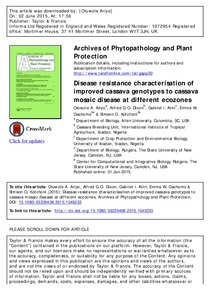| dc.contributor.author | Ariyo, O.A. |
| dc.contributor.author | Dixon, Alfred G.O. |
| dc.contributor.author | Atiri, G.I. |
| dc.contributor.author | Gachomo, E.W. |
| dc.contributor.author | Kotchoni, S.O. |
| dc.date.accessioned | 2019-12-04T10:58:01Z |
| dc.date.available | 2019-12-04T10:58:01Z |
| dc.date.issued | 2015 |
| dc.identifier.citation | Ariyo, O.A., Dixon, A.G., Atiri, G.I., Gachomo, E.W., & Kotchoni, S.O. (2015). Disease resistance characterisation of improved cassava genotypes to cassava mosaic disease at different ecozones. Archives of Phytopathology and Plant Protection, 48(6), 504-518. |
| dc.identifier.issn | 0323-5408 |
| dc.identifier.uri | https://hdl.handle.net/20.500.12478/897 |
| dc.description | Published online: 01 Jun 2015. |
| dc.description.abstract | Twenty-two cassava genotypes and eight controls were evaluated in two cropping
seasons for resistance to cassava mosaic disease (CMD) at the International Institute
of Tropical Agriculture (IITA) fields, located at different ecozones of Nigeria. Disease
incidence (DI) and index of symptom severity data were obtained monthly at
each location and genotype. Symptomatic leaves were also collected during evaluation
at each location, and virus was indexed by amplification in polymerase chain
reaction. Significant differences within and across locations were observed in the
reactions of cassava genotypes to CMD. DI across cassava genotypes was
significantly (p = 0.05) highest in the Ibadan (22.6%), followed by Onne (19.3%).
Generally, plants of clones 96/0860, 96/1439, 96/0160, 96/1089A, 96/1632, 96/1613,
96/1708, 96/0191, 96/0249 and 96/1565 had significantly lower values of DI in each
location. African cassava mosaic virus in single infection was the predominant causal
agent of CMD in IITA experimental fields under study.Twenty-two cassava genotypes and eight controls were evaluated in two cropping
seasons for resistance to cassava mosaic disease (CMD) at the International Institute
of Tropical Agriculture (IITA) fields, located at different ecozones of Nigeria. Disease
incidence (DI) and index of symptom severity data were obtained monthly at
each location and genotype. Symptomatic leaves were also collected during evaluation
at each location, and virus was indexed by amplification in polymerase chain
reaction. Significant differences within and across locations were observed in the
reactions of cassava genotypes to CMD. DI across cassava genotypes was
significantly (p = 0.05) highest in the Ibadan (22.6%), followed by Onne (19.3%).
Generally, plants of clones 96/0860, 96/1439, 96/0160, 96/1089A, 96/1632, 96/1613,
96/1708, 96/0191, 96/0249 and 96/1565 had significantly lower values of DI in each
location. African cassava mosaic virus in single infection was the predominant causal
agent of CMD in IITA experimental fields under study.Twenty-two cassava genotypes and eight controls were evaluated in two cropping
seasons for resistance to cassava mosaic disease (CMD) at the International Institute
of Tropical Agriculture (IITA) fields, located at different ecozones of Nigeria. Disease
incidence (DI) and index of symptom severity data were obtained monthly at
each location and genotype. Symptomatic leaves were also collected during evaluation
at each location, and virus was indexed by amplification in polymerase chain
reaction. Significant differences within and across locations were observed in the
reactions of cassava genotypes to CMD. DI across cassava genotypes was
significantly (p = 0.05) highest in the Ibadan (22.6%), followed by Onne (19.3%).
Generally, plants of clones 96/0860, 96/1439, 96/0160, 96/1089A, 96/1632, 96/1613,
96/1708, 96/0191, 96/0249 and 96/1565 had significantly lower values of DI in each
location. African cassava mosaic virus in single infection was the predominant causal
agent of CMD in IITA experimental fields under study. |
| dc.language.iso | en |
| dc.subject | Cassava Mosaic |
| dc.subject | Disease Resistance |
| dc.subject | Genotypes |
| dc.title | Disease resistance characterisation of improved cassava genotypes to Cassava Mosaic Disease at different ecozones |
| dc.type | Journal Article |
| dc.description.version | Peer Review |
| cg.contributor.crp | Roots, Tubers and Bananas |
| cg.contributor.affiliation | Allen University |
| cg.contributor.affiliation | International Institute of Tropical Agriculture |
| cg.contributor.affiliation | University of Ibadan |
| cg.contributor.affiliation | State University of New Jersey |
| cg.coverage.region | Africa |
| cg.coverage.region | West Africa |
| cg.coverage.country | Nigeria |
| cg.isijournal | ISI Journal |
| cg.authorship.types | CGIAR and developing country institute |
| cg.iitasubject | Cassava |
| cg.journal | Archives of Phytopathology and Plant Protection |
| cg.howpublished | Formally Published |
| cg.accessibilitystatus | Limited Access |
| local.dspaceid | 76396 |
| cg.identifier.doi | http://www.tandfonline.com/action/showCitFormats?doi=10.1080/03235408.2015.1045233 |

